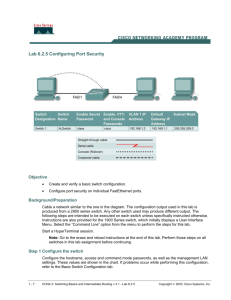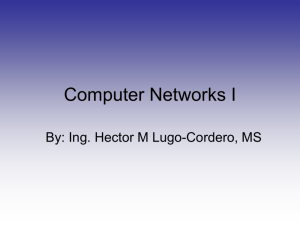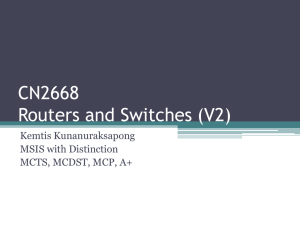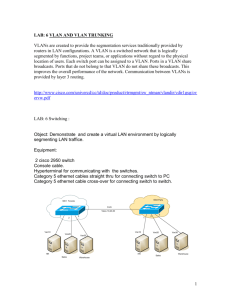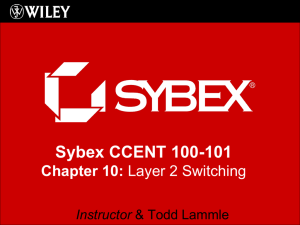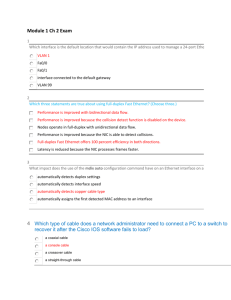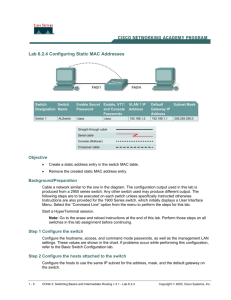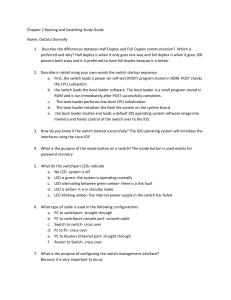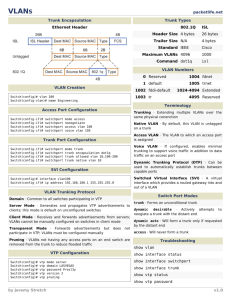Lab 6.2.6 Add, Move, and Change MAC Addresses
advertisement
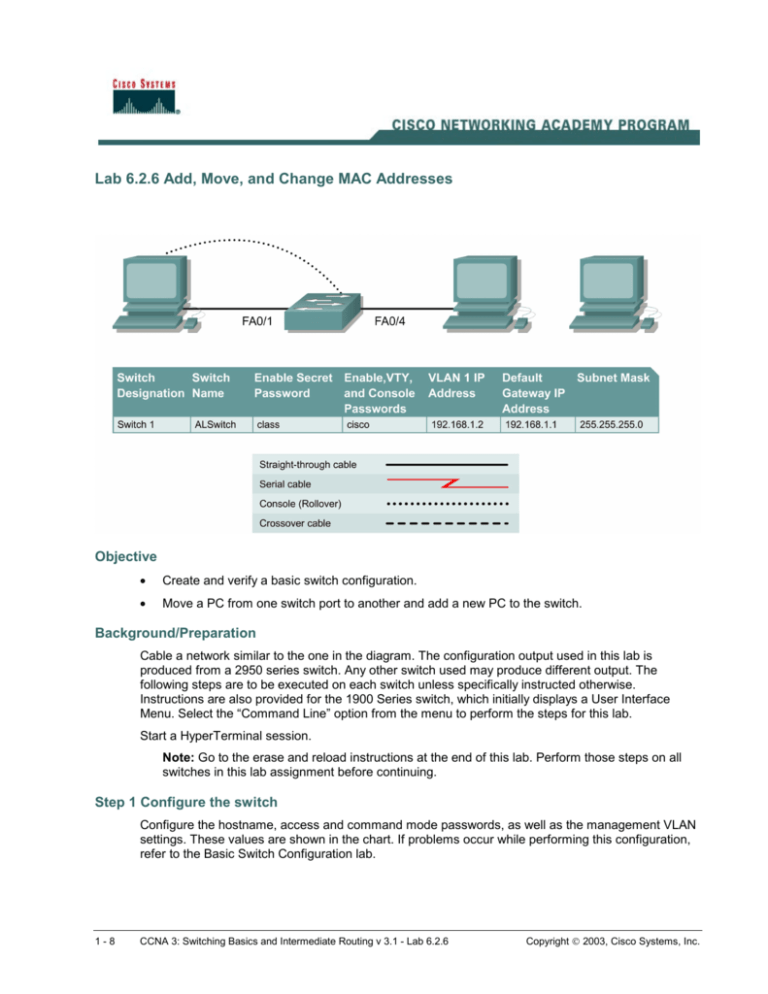
Lab 6.2.6 Add, Move, and Change MAC Addresses Objective • Create and verify a basic switch configuration. • Move a PC from one switch port to another and add a new PC to the switch. Background/Preparation Cable a network similar to the one in the diagram. The configuration output used in this lab is produced from a 2950 series switch. Any other switch used may produce different output. The following steps are to be executed on each switch unless specifically instructed otherwise. Instructions are also provided for the 1900 Series switch, which initially displays a User Interface Menu. Select the “Command Line” option from the menu to perform the steps for this lab. Start a HyperTerminal session. Note: Go to the erase and reload instructions at the end of this lab. Perform those steps on all switches in this lab assignment before continuing. Step 1 Configure the switch Configure the hostname, access and command mode passwords, as well as the management VLAN settings. These values are shown in the chart. If problems occur while performing this configuration, refer to the Basic Switch Configuration lab. 1-8 CCNA 3: Switching Basics and Intermediate Routing v 3.1 - Lab 6.2.6 Copyright 2003, Cisco Systems, Inc. Step 2 Configure the hosts attached to the switch Configure the hosts to use the same IP subnet for the address, mask, and default gateway as on the switch. There is a third host needed for this lab. It needs to be configured with the address 192.168.1.7. The subnet mask is 255.255.255.0 and the default gateway is 192.168.1.1. Do not connect this PC to the switch yet. Step 3 Verify connectivity a. To verify that the hosts and switch are correctly configured, ping the switch IP address from the hosts. b. Were the pings successful? __________________________________________________ c. If the answer is no, troubleshoot the hosts and switch configurations. Step 4 Record the MAC addresses on the hosts a. To determine and record the layer 2 addresses of the PC network interface cards enter the following. If running Windows 98, check by using Start > Run > winipcfg. Click on More info. If running Windows 2000, check by using Start > Run > cmd > ipconfig /all. b. PC1: ___________________________________________________________________ c. PC4: ___________________________________________________________________ Step 5 Determine what MAC addresses the switch has learned a. Determine what MAC addresses the switch has learned by using the show mac-addresstable command at the privileged exec mode prompt: ALSwitch#show mac-address-table b. How many dynamic addresses are there? ________________________________________ c. How many total MAC addresses are there? _______________________________________ d. Do the MAC addresses match the host MAC addresses? _____________________________ Step 6 Determine the MAC table options To determine the options that the mac-address-table command has using enter the ? option as follows: ALSwitch(config)#mac-address-table ? Step 7 Set up a static MAC address To setup a static MAC address on Fast Ethernet interface 0/4 enter the following: Note: Use the address that was recorded for PC4 in Step 4. The MAC address 00e0.2917.1884 is used in the example statement only. ALSwitch(config)#mac-address-table static 00e0.2917.1884 interface fastethernet 0/4 vlan 1 2-8 CCNA 3: Switching Basics and Intermediate Routing v 3.1 - Lab 6.2.6 Copyright 2003, Cisco Systems, Inc. 1900: ALSwitch(config)#mac-address-table permanent 00e0.2917.1884 ethernet 0/4 Step 8 Verify the results a. Enter the following to verify the MAC address table entries: ALSwitch#show mac-address-table b. How many static addresses are there? __________________________________________ Step 9 List port security options a. To determine the options for setting port security on interface Fast Ethernet 0/4. Type port security ? from the interface configuration prompt for Fast Ethernet port 0/4. ALSwitch(config)#interface fastethernet 0/4 ALSwitch(config-if)#switchport port-security ? aging Port-security aging commands mac-address Secure mac address maximum Max secure addrs violation Security Violation Mode <cr> 1900: ALSwitch(config)#interface ethernet 0/4 ALSwitch(config-if)#port secure ? max-mac-count Maximum number of addresses allowed on the port <cr> b. Allow the switchport on Fast Ethernet 0/4 to accept only one device by typing port-security as follows: ALSwitch(config-if)#switchport mode access ALSwitch(config-if)#switchport port-security ALSwitch(config-if)#switchport port-security mac-address sticky 1900: ALSwitch(config-if)#port secure Step 10 Verify the results a. Enter the following to verify the mac–address-table entries: ALSwitch#show mac-address-table b. How are the address types listed for the two MAC addresses? ________________________ 3-8 CCNA 3: Switching Basics and Intermediate Routing v 3.1 - Lab 6.2.6 Copyright 2003, Cisco Systems, Inc. Step 11 Show the running configuration file a. In the listing of the running configuration are there statements that directly reflect the security implementation? __________________________________________________________ b. What do those statements mean? ______________________________________________ __________________________________________________________________________ Step 12 Limit the number of hosts on each port a. Enter the following on interface Fast Ethernet 0/4 to set the port security maximum MAC count to 1: ALSwitch(config)#interface fastethernet 0/4 ALSwitch(config-if)#switchport port-security maximum 1 1900: ALSwitch(config)#interface ethernet 0/4 ALSwitch(config-if)#port secure max-mac-count 1 b. Disconnect the PC that is attached to Fast Ethernet 0/4. Connect to the port that the PC has been given the IP address 192.168.1.7. This PC has not yet been attached to the switch. To generate some traffic ping the switch address 192.168.1.2 with the -n 50 option. For example ping 192.168.1.2 –n 50, where 50 is the number of pings sent. Step 13 Move host a. Take the PC that had previously been connected to Fast Ethernet 0/4 and reconnect it to Fast Ethernet 0/8. The PC has been moved to a new location. This could be to another VLAN but in this instance all switch ports are in VLAN 1 and network 192.168.1.0. b. From this PC on Fast Ethernet 0/8, ping 192.168.1.2 –n 50 c. Was the ping successful? ___________________________________________________ d. Why or why not? __________________________________________________________ e. Enter the following to show the mac-address-table. ALSwitch#show mac-address-table f. Record observations about the show output. ______________________________________ __________________________________________________________________________ Step 14 Clear MAC table a. Enter the following to clear the mac-address-table: Note: This will unlock the MAC addresses from security and allow a new address to be registered. ALSwitch#clear mac-address-table dynamic b. From the PC on the Fast Ethernet 0/8, ping 192.168.1.2 –n 50. 4-8 CCNA 3: Switching Basics and Intermediate Routing v 3.1 - Lab 6.2.6 Copyright 2003, Cisco Systems, Inc. c. Was the ping successful? ___________________________________________________ d. If not troubleshoot as necessary. Step 15 Change security settings a. Enter the following to show the mac-address-table: ALSwitch#show mac-address-table b. Notice that Fast Ethernet 0/4 is secure. However, that security should be applied to the machine on port 0/8, as this is the machine that was moved from port 0/4. Remove port security from interface Fast Ethernet 0/4 as follows: ALSwitch(config)#interface fastethernet 0/4 ALSwitch(config-if)#no switchport port-security ALSwitch(config-if)#no switchport port-security mac-address sticky ALSwitch(config-if)#no switchport port-security mac-address sticky 0008.744d.8ee2 ALSwitch(config-if)#shutdown ALSwitch(config-if)#no shutdown 1900: ALSwitch(config)#interface ethernet 0/4 ALSwitch(config-if)#no port secure c. Apply port security with a max-mac-count of 1 to interface Fast Ethernet 0/8 as follows: ALSwitch(config)#interface fastethernet 0/8 ALSwitch(config-if)#switchport mode access ALSwitch(config-if)#switchport port-security ALSwitch(config-if)#switchport port-security mac-address sticky ALSwitch(config-if)#switchport port-security maximum 1 1900: ALSwitch(config)#interface ethernet 0/8 ALSwitch(config-if)#port secure max-mac-count 1 d. Enter the following to clear the mac-address-table. Note: Clearing individual entries could have also been done. ALSwitch#clear mac-address-table Step 16 Verify the results a. Verify that the mac-address-table has been cleared. ALSwitch#show mac-address-table b. Can all PCs still successfully ping each other? ______________ c. 5-8 If not troubleshoot the switch and PCs. CCNA 3: Switching Basics and Intermediate Routing v 3.1 - Lab 6.2.6 Copyright 2003, Cisco Systems, Inc. Step 17 Exit the switch Type exit to leave the switch welcome screen as follows: Switch#exit Once the steps are complete, logoff by typing exit, and turn all the devices off. Then remove and store the cables and adapter. Erasing and Reloading the Switch For the majority of the labs in CCNA 3 and CCNA 4 it is necessary to start with an unconfigured switch. Use of a switch with an existing configuration may produce unpredictable results. These instructions allow preparation of the switch prior to performing the lab so previous configuration options do not interfere. The following is the procedure for clearing out previous configurations and starting with an unconfigured switch. Instructions are provided for the 2900, 2950, and 1900 Series switches. 2900 and 2950 Series Switches 1. Enter into the privileged EXEC mode by typing enable. If prompted for a password, enter class (if that does not work, ask the instructor). Switch>enable 2. Remove the VLAN database information file. Switch#delete flash:vlan.dat Delete filename [vlan.dat]?[Enter] Delete flash:vlan.dat? [confirm] [Enter] If there was no VLAN file, this message is displayed. %Error deleting flash:vlan.dat (No such file or directory) 3. Remove the switch startup configuration file from NVRAM. Switch#erase startup-config The responding line prompt will be: Erasing the nvram filesystem will remove all files! Continue? [confirm] Press Enter to confirm. The response should be: Erase of nvram: complete 6-8 CCNA 3: Switching Basics and Intermediate Routing v 3.1 - Lab 6.2.6 Copyright 2003, Cisco Systems, Inc. 4. Check that VLAN information was deleted. Verify that the VLAN configuration was deleted in Step 2 using the show vlan command. If previous VLAN configuration information (other than the default management VLAN 1) is still present it will be necessary to power cycle the switch (hardware restart) instead of issuing the reload command. To power cycle the switch, remove the power cord from the back of the switch or unplug it. Then plug it back in. If the VLAN information was successfully deleted in Step 2, go to Step 5 and restart the switch using the reload command. 5. Software restart (using the reload command) Note: This step is not necessary if the switch was restarted using the power cycle method. a. At the privileged EXEC mode enter the command reload. Switch(config)#reload The responding line prompt will be: System configuration has been modified. Save? [yes/no]: b. Type n and then press Enter. The responding line prompt will be: Proceed with reload? [confirm] [Enter] The first line of the response will be: Reload requested by console. After the switch has reloaded, the line prompt will be: Would you like to enter the initial configuration dialog? [yes/no]: c. Type n and then press Enter. The responding line prompt will be: Press RETURN to get started! [Enter] 1900 Series Switches 1. Remove VLAN Trunking Protocol (VTP) information. #delete vtp This command resets the switch with VTP parameters set to factory defaults. All other parameters will be unchanged. 7-8 CCNA 3: Switching Basics and Intermediate Routing v 3.1 - Lab 6.2.6 Copyright 2003, Cisco Systems, Inc. Reset system with VTP parameters set to factory defaults, [Y]es or [N]o? Enter y and press Enter. 2. Remove the switch startup configuration from NVRAM. #delete nvram This command resets the switch with factory defaults. All system parameters will revert to their default factory settings. All static and dynamic addresses will be removed. Reset system with factory defaults, [Y]es or [N]o? Enter y and press Enter. 8-8 CCNA 3: Switching Basics and Intermediate Routing v 3.1 - Lab 6.2.6 Copyright 2003, Cisco Systems, Inc.
